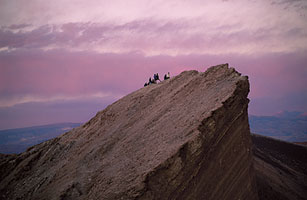
Where's the hotel? Luxury properties are coming to the Atacama
When the latest 007 flick Quantum of Solace exploded on the world's screens last year, its desert climax highlighted the fact that South America is not all steaming jungles and snowcapped peaks. The continent is also the site of the most arid place on earth — the stunning Atacama Desert in northern Chile.
The area is a fitting locale for part of the film's plot, which involves the sinister Quantum organization in an attempt to cut off a country's precious supply of fresh water. Only parts of Antarctica see less rainfall than the Atacama — a strip of land about 600 miles (1,000 km) long, sandwiched between the Andes and the Pacific Ocean. NASA has conducted training missions there, since the rugged landscape is the closest to a Martian surface on our planet, and some of the world's most powerful telescopes are located in the Atacama because its air has little to no moisture. Indeed, parts of the desert are so dry that no life grows — not even bacteria. Of course, all this makes the Atacama seem like the world's most unlikely place for tourism, but its remoteness and superlatives are exactly the things that attract travelers.
"When we opened in 1998, everyone thought we were crazy," says Maurice Dides, the manager of the Hotel de Larache, www.explora.com, located near the sleepy, sandy, stucco village of San Pedro de Atacama. "Now, we are doing renovations just to keep up with all the new properties opening up here."
Since 2006, a number of lodgings have popped up around San Pedro, each more tasteful and upscale than the last. The intimate Awasi, www.awasi.com, feels like the kind of private compound a Hollywood celebrity would relish, while the brand new Hotel Kunza, www.hotelkunza.cl, with its desert-themed spa, is taking a page out of the Four Seasons book. Although put on the travel map by trailblazing backpackers over a decade ago, San Pedro now sees the famous and the well-heeled: Cameron Diaz and Drew Barrymore have both visited. Small wonder that even more lavish resorts in San Pedro are on the drawing board.
Most lodges in San Pedro include meals, drinks and excursions into the desert in their room price. Die-hard adventurers trudge up the 100-meter-plus mocha sand dunes of the Valle de la Muerte and surf down them on specially outfitted sand boards. Others opt for hikes up the cone-shaped Licancabur volcano, on the border between Chile and Bolivia, with its 19,420-ft. (5,920 m) summit topped by Incan ruins. On any given morning, you'll find groups of travelers dipping into the steaming hot springs at the Tatio Geysers, where over 80 vents make it the largest geyser field in the southern hemisphere. The Atacama's high-altitude plains are also home to flamingo-filled salt lakes, where dainty vicuñas (smaller cousins to the llama) go to drink while strange-looking vizcachas (looking like a cross between a rabbit and a squirrel) hop by.
Some political tensions hang in the desert air. Bolivia still claims parts of the Atacama won by Chile in the 1800s War of the Pacific, and Chilean President Michelle Bachelet and Bolivian President Evo Morales continue to work on patching up the ongoing border dispute. More recently, black flags have fluttered over San Pedro and other Atacama towns in protest at a planned water project that will divert resources from the Tatio Geysers and other Atacama water sources for state-owned mining projects. "Nobody has told us how these water resources are going to be replenished. Who will assure us that we are going to be able to continue to live in this region?" asks Sandra Berna Martinez, mayor of the San Pedro district.
Perhaps 007 will have a solution.